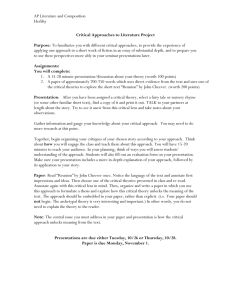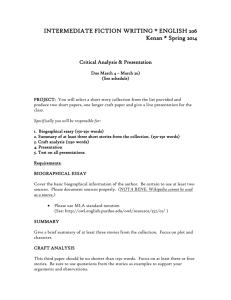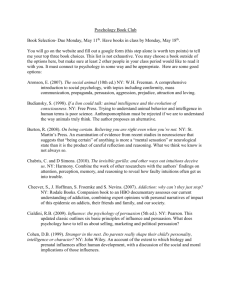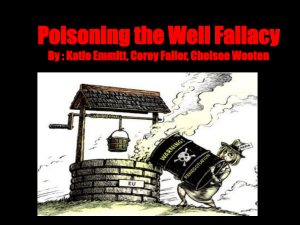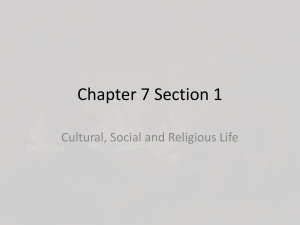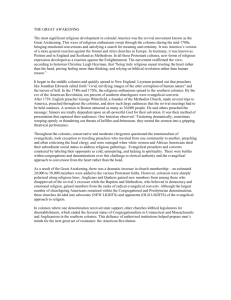Transatlantic Visitors and Evangelical Networks 1829-1861
advertisement
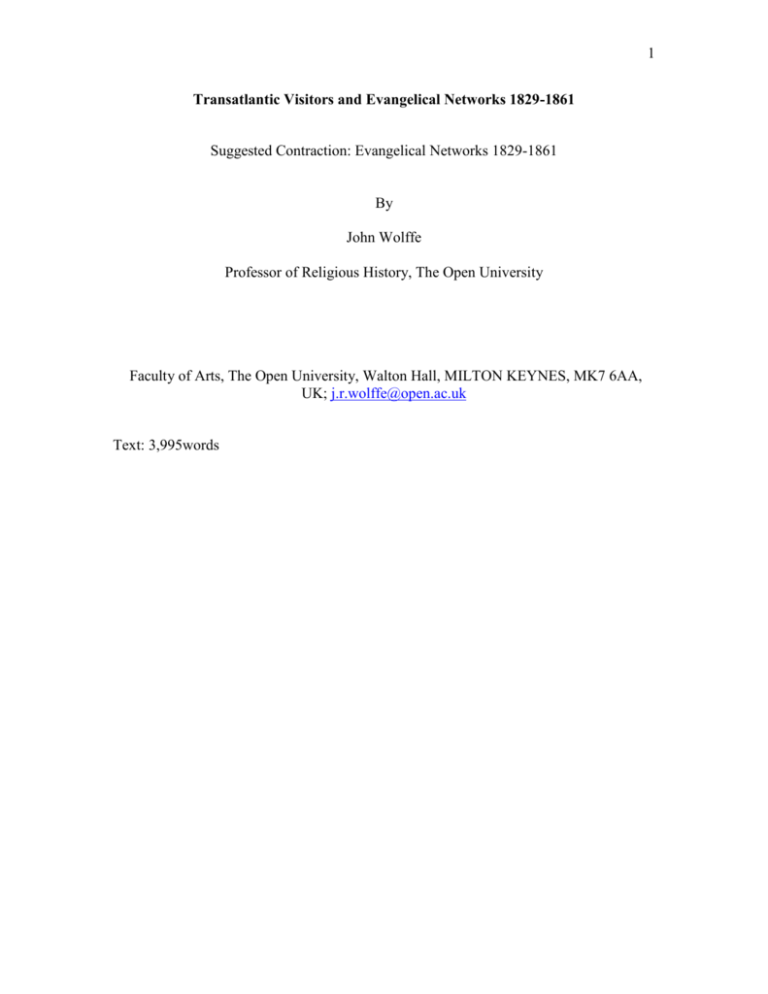
1 Transatlantic Visitors and Evangelical Networks 1829-1861 Suggested Contraction: Evangelical Networks 1829-1861 By John Wolffe Professor of Religious History, The Open University Faculty of Arts, The Open University, Walton Hall, MILTON KEYNES, MK7 6AA, UK; j.r.wolffe@open.ac.uk Text: 3,995words 2 In June 1829 John Angell James, minister of Carr’s Lane Congregational Church in Birmingham, wrote to his friend William Wilson Patton, minister of a Presbyterian Church in New York, thanking him for his congregation’s interest in the spiritual welfare of the British churches. I was touched to the very centre of my heart with the idea of being the object of Christian sympathy and kindness, and the subject of prayer, by a church on the other side of the Atlantic. Herein indeed is the communion, not only of the saints, but of the churches, and a proof and a fruit of that union of all believers in Christ, which cannot be dissolved nor altogether interrupted by the intervention of oceans, or the distinctions of separate nations, or the differences of various denominations. Yes, we are all one in Christ. There is, there can be, but one church. 1 James’s friendship with Patton had developed in face to face encounters during the latter’s visits to Britain in 1825 and 1828. Such contacts and visits were a prominent feature of evangelical life in the mid-nineteenth century, reaching their culmination in the founding conference of the Evangelical Alliance in London in 1846, at which out of a total of 910 participants, seventy-four had come from the United States, and a further seven from British North America, an impressive attendance in view of the rigours of transatlantic travel.2 Although transatlantic evangelical networks in the eighteenth century have received significant attention from scholars, their development in the nineteenth century has been relatively little studied. Their importance was demonstrated a generation ago by 1 R.W. Dale, The Life and Letters of John Angell James (London, 1861), 252-3. J.W. Massie, The Evangelical Alliance; Its Origin and Development (London, 1847), 286; Evangelical Alliance: Report of the Proceedings of the Conference Held at Freemasons Hall, London (London, 1847), pp. lxxvii-xcvii. 2 3 Richard Carwardine’s pioneering monograph, Transatlantic Revivalism: Popular Evangelicalism in Britain and America 1790-1865 (Westport CT, 1978), but despite other significant subsequent work,3 much still remains to be done. In the context of this volume they serve as a revealing case study, not only of the importance of international networks, but also of their limitations. Indeed on occasions their very existence highlighted consciousness of difference. Visits by American evangelicals to Europe were significantly more numerous than British visits to the United States, although in assessing wider patterns of influence it is important to take into account permanent emigrants: as late as the 1850s over 10% of recruits to the itinerant ministry of the Methodist Episcopal Church in the United States had been born in Britain.4 The best-documented British evangelical visits to the United States in this period were factfinding tours in the mid-1830s by the Congregationalists Andrew Reed and James Matheson, and the Baptists Francis Cox and James Hoby.5 In the immediate aftermath of the Disruption in 1843, William Cunningham led a fundraising deputation on behalf of the Free Church of Scotland, which reportedly had a powerful influence in drawing American evangelical denominations towards each other, and in bridging divisions in the Presbyterian church there.6 American evangelical visitors to Europe crossed the Atlantic with a variety of motives. These ranged from a sense of clear call to preach revival in the old world to 3 For an overview see John Wolffe, The Expansion of Evangelicalism: The Age of Wilberforce, More, Chalmers and Finney (Nottingham, 2006). 4 Carwardine, Transatlantic Revivalism, 35. 5 Andrew Reed and James Matheson, A Narrative of the Visit to the American Churches by the Deputation from the Congregational Union of England and Wales (2 vols, London, 1835); F.A.Cox and J. Hoby, The Baptists in America: A Narrative of the Deputation of the Baptist Union in England to the United States and Canada (London, 1836). 6 New College, Edinburgh, Chalmers Papers, CHA 4.315.68-9 William Buell Sprague to Chalmers, 14 April 1844. 4 what can be termed religious tourism, as ministers exhausted by their pulpit labours in the United States sought physical and spiritual refreshment in a temporary change of scene. In between was a spectrum of fact-finding, literary, fundraising, and educational endeavours. The revivalists included the eccentric Lorenzo Dow in the early years of the century, and Asahel Nettleton, who came to Britain in 1831, but unfortunately seemed ‘to have a special faculty for sending people to sleep’. Later such visitors, who included the Presbyterian Edward Norris Kirk in the 1830s and the Methodists James Caughey and Zilpha Elaw – a black woman - in the 1840s achieved a happier balance between fervour and caution. Charles Finney visited Britain twice in 1849-50 and 1859-60. For him the motivation for these journeys was unambiguously spiritual: when in London he concentrated his energies on the preaching of the gospel.7 William Sprague crossed the Atlantic in 1828 ‘for the benefit of his health’, and subsequently wrote up his experiences for publication in The New York Observer. As well as visiting the sights, he went to hear sermons by the best-known preachers, and sought out celebrities including William Wilberforce and Hannah More.8 Prominent British evangelicals became used to receiving such Americans: in her old age Hannah More charmed her visitors and ‘America, and the cause of religion there, seemed very much to interest her’; Edward Irving said that ‘any American minister was welcome not only to his pew but to his heart, even without the formality of an introduction’; Thomas Carwardine, Transatlantic Revivalism., 67, 74, 102-33, 145; ‘Memoirs of the Life, Religious Experience, Ministerial Travels and Labors of Mrs. Zilpha Elaw’ in W.L. Andrews, ed., Sister of the Spirit: Three Black Women’s Autobiographies of the Nineteenth Century (Bloomington, IN, 1986), 138-60. 8 W.B. Sprague, Letters from Europe in 1828 (New York, 1828). 7 5 Chalmers was gratified by the numerous Americans who visited him, and kept a special page for them in his memorandum book.9 A few Americans became insatiable travellers: Charles Pettit McIlvaine, the second Episcopalian bishop of Ohio, crossed the Atlantic nine times; the Presbyterian Robert Baird did so eighteen times.10 As an Episcopalian, and a bishop from 1831, McIlvaine had a ready entrée into influential circles in Britain: he became well-known in evangelical Anglican networks there, and in 1861 when relations between Britain and the United States were dangerously strained over the Trent affair, Abraham Lincoln used him as an informal mediator.11 Baird, who lived in Europe for long periods, was outstanding in the geographical range of his travels and the quality of his writing. He wrote both Religion in America (1844), interpreting his own country for Europeans, and Sketches of Protestantism in Italy (1845). His Visit to Northern Europe (1841) was a survey of Scandinavia, including numerous pithy judgements on religion and morals that revealed characteristically American presuppositions, particularly regarding the negative consequences of links between church and state. In Denmark he met Grundtvig, describing him as ‘a sweet poet, of quite an original cast of mind.’ He noted that ‘the truth is slowly, but surely gaining ground’, but felt that ‘there is a degree of intolerance in this interesting country which is most deplorable,’ shown in the persecution of Baptists.12 He was impressed by the patriotism and honesty of the Norwegians, but worried by high rates of illegitimacy 9 William Carus, Memorials of the Right Reverend Charles Pettit McIlvaine (London, 1882), 53; W.B. Sprague, Visits to European Celebrities (Boston, 1855), 16, 260. 10 Donald M. Lewis, ed., The Blackwell Dictionary of Evangelical Biography (2 vols, Oxford, 1995), i. 49, ii. 721. 11 Carus, McIlvaine, 217-8. 12 Robert Baird, Visit to Northern Europe (2 vols, New York, 1841), i. 311-4. 6 and drunkenness. He judged the church to be hampered both by large parishes and the constraints of state connection, which led to the appointment of pastors who had not themselves experienced the saving power of the gospel. Nevertheless he believed there were some ‘excellent ministers’, naming Bishop Buggé of Trondheim and Dr Wexels of Christiania.13 In Sweden he noted the inadequate church provision in Stockholm, and also dwelt on high levels of criminality, of which an underlying cause was ‘the want of a thoroughly efficient presentation of the Gospel’. He praised the work of George Scott, minister at the Wesleyan Mission, who was drawing large congregations of Swedish as well as English speakers. Baird himself had conducted the first English service in the mission’s new chapel in 1840, and was instrumental in arranging for Scott to visit the United States in 1841. With regard to the national church in Sweden he acknowledged that the ministry was ‘numerous, talented, well-instructed, learned even’ but ‘it is one of the evils of an established church, with its system of patronage more or less extensive, that it infallibly leads men to regard the ministry too much in the light of a secular employment’.14 He perceived the situation to be similar in Finland, acknowledging that there ‘were some truly pious and excellent men among the clergy’, but that in general there was ‘little zeal, and … preaching … far from such as it should be.’15 The remainder of this paper concentrates on George Barrell Cheever (1807-90), a New Englander who made three visits to Europe, in 1837-9, 1844 and 1860-1. In his first transatlantic journey he travelled particularly extensively, reaching as far as Egypt, Palestine and Turkey. Born in Maine, Cheever began his ministry as a Congregationalist 13 Ibid., ii. 66-77. Ibid., ii. 181-204; George Scott, Tellstrőm and Lapland with an Introductory Sketch of the Stockholm Mission (London, 1868), 12-15. 15 Ibid., ii. 334. 14 7 in Massachusetts, but spent most of his career in New York, first as pastor of Allen Street Presbyterian Church and then the Congregational Church of the Puritans. He was passionately opposed to alcoholic drink, state-church connections, Roman Catholicism, and above all, slavery. These attitudes were both expressed and developed in his richlydocumented European journeys, which provide a useful standpoint from which to explore the changing dynamics of transatlantic evangelical networks.16 Cheever openly affirmed that ‘an American, wherever he goes in the world, should go with the feeling that his own country is the best in the world,’ although such a conviction should be carried as a ‘gentle’ and ‘quiet’ rather than as a ‘proud’ feeling.17 He thus reflected the general ambivalence of American travellers towards England: an unspoken consciousness of their own cultural inferiority was counteracted by a readiness to assert spiritual and political superiority.18 While he was repelled by Roman Catholic shrines, he explicitly presented travel as a Bunyanesque Protestant pilgrimage, with no single topographical destination, but as a means to spiritual growth.19 He had a strong sense of divine providence, believing that God was watching over him in distant lands, and also caring for his loved ones far away. He regarded such separation as a ‘means of grace … adapted to make us painfully feel that we are strangers and pilgrims, and that we must set our affections on things above, and on that world, where we do hope to meet without parting.’ Travel also enhanced his reverence for the Sabbath, both through his reaction against its nonobservance in continental Europe, and through his sense that it For an overview of Cheever’s life see Robert M. York, George B. Cheever, Religious and Social Reformer (Orono, ME, 1955). 17 G.B. Cheever, Wanderings of A Pilgrim in the Shadow of Mont Blanc and the Jungfrau Alp (Glasgow, 1847). 18 Compare Christopher Mulvey, Transatlantic Manners: Social Patterns in Nineteenth Century AngloAmerican Literature (Cambrige, 1990), 3-4. 19 [American Antiquarian Society, Worcester, Massachusetts] C[heever] P[apers], GBC to Charlotte BC (mother) and Elizabeth BC (sister), 30 August 1844; York, Cheever, 110-1. 16 8 provided him with a recurrent fixed point of spiritual calm in diverse environments.20 He had a romantic fascination with nature, and perceived it as conveying spiritual lessons. For example he represented the effect of Lake Geneva on the Rhone as an allegory of personal conversion, in that it enters the lake as a turbulent, mountain torrent, full of rocks and mud but leaves it as a clean, sparkling river, ‘reflecting the hues of heaven’.21 On arrival in London in May 1837 Cheever lodged in ‘a quiet and select private boarding house’ with a ‘pious family’ in Salisbury Square. He purposefully pursued his contacts. He was delighted at a chance meeting with Edward Kirk, and the two American ministers visited the Tower of London with James Silk Buckingham, MP, a link presumably arising from Cheever’s temperance interests. He made contact with the leading Congregationalists, Robert Vaughan and Joseph Fletcher. Vaughan also took him sightseeing together ‘with some other American gentlemen’ and he preached for Fletcher. In the meantime he attended the evangelical May meetings at Exeter Hall, finding in them evidence that there was ‘more piety in England than I expected’. He wrote vivid pen portraits of leading speakers such as Lord Ashley, Edward Bickersteth and Hugh Stowell for the New York Observer.22 Cheever had met the slavery abolitionist George Thompson in 1834 during the latter’s visit to the United States,23 and they now travelled to Scotland together enabling Cheever to use Thompson’s networks to extend his own. When they arrived in Glasgow, friends of Thompson’s immediately rescued Cheever from a hotel and insisted that he stay with them, enabling him to be ‘quite domesticated’ in an ‘affectionate family’. 20 CP, GBC to Charlotte BC, 13 May 1837, 8 Oct 1837; GBC to Elizabeth BC, 21 July 1844. Cheever, Wanderings of A Pilgrim, 180-1. 22 CP, GBC to Charlotte BC, 13 May 1837, to Nathaniel BC (brother), 18 May, 4 June 1837; N[ew] Y[ork] O[bserver], 22 July 1837. 23 York, Cheever, 84. 21 9 Through them he was introduced to the leading Congregational minister Ralph Wardlaw, for whom he preached. When he moved on to Edinburgh his contacts included the Congregationalist William Lindsay Alexander, the prominent United Associate minister John Brown, and the philanthropist John Henderson.24 The readiness with which Cheever was welcomed in England and Scotland indicated the strength of transatlantic evangelical ties. Nevertheless his experiences also revealed significant differences in outlook between British and American evangelicals. Cheever’s opposition to slavery was shared by his hosts, but when he spoke at a meeting in Glasgow he ‘was very plain with Old England [sic], and took the opportunity to pay off old scores in relation to some of her rebukes to us.’25 Attitudes to alcohol also differed. He noted disapprovingly that some used brandy as ‘physical preparation for the fatigues of preaching.’ At a dinner party in Edinburgh, although his temperance arguments were courteously listened to even as the decanters circulated, he was shocked to see a distinguished cleric holding forth on the mode of the Holy Spirit’s operation on the heart, while he had a pinch of snuff in one hand and a glass of wine in the other. ‘In this part of the world’, Cheever wrote, ‘they have not yet begun to feel the disgusting irreverence of such a juxtaposition.’26 The sharpest divergences of outlook were on church-state relations and the voluntary question, where his stance was more uncompromising than that of his British Nonconformist friends. This was a time of particular tension over the future of the Church of England, and when the voluntary controversy in Scotland was at its height. In Edinburgh he caused offence by a casual and factual remark regarding the voluntary 24 CP, GBC to Charlotte BC, 14 June 1837, to Elizabeth BC, 20 June 1837; GBC Journal, 17 July 1837. CP, GBC to Elizabeth BC, 20 June 1837. 26 NYO, 12 August 1837; GBC Journal, 18, 22 July 1837. 25 10 nature of support for religion in America. He observed that principles regarded in the United States ‘almost as truisms’ were in Britain ‘strenuously opposed and decried as though they were the tenets of Pandemonium’.27 He regretted that an evangelical leader of Thomas Chalmers’s stature should be throwing his weight into the defence of Establishment, but the separation of church and state was so axiomatic to Cheever, that he did not make any serious attempt to understand the counter arguments even when they were advanced by fellow evangelicals. His polemics against the socially and spiritually corrupting effect of establishments no doubt served to confirm the prejudices of his American readers. He was also, wrongly, convinced that their demise was imminent. Nevetheless Cheever was concerned that Dissenters, by engaging in a primarily political campaign against the Church of England, risked damaging their own spirituality. He praised the ‘spirituality and evangelical faithfulness’ of Anglicans such as Edward Bickersteth and Baptist Noel, and believed Dissenters would only prevail against them if they could maintain a similar quality of ‘primitive piety’.28 During the five years preceding Cheever’s second visit to Europe in 1844, his active involvement in the controversy with the Roman Catholic Church over the use of the Bible in New York public schools, brought anti-Catholicism more to the centre of his preoccupations.29 As soon as he arrived at Liverpool he began to pen polemics against Rome for publication in New York, rejoicing that a priest had to pay duty on his books and fearing an impending war in Europe between the forces of Romanism and those of Protestantism.30 He was alarmed at the influence of Tractarianism in the Church of 27 NYO, 6 January 1838. NYO, 12 August 1837, 23 December 1837, 6 January 1838. 29 York, Cheever, 102-6. 30 New York Evangelist, 8 August 1844. 28 11 England, judging it to be ‘not one whit better than Romanism’, and worried that within a few years half of England would ‘march over to the Pope’. Nevertheless, while he thought such an ‘extreme tendency to antiquity’ highly dangerous and actually revolutionary, he acknowledged a converse deficiency in American religious life: ‘In our country we need more of the picturesque, more romantic variety and less precision, more of the ornamental.’31 When he crossed the Channel, Cheever’s anxieties about Rome were reinforced. He perceived French Protestantism as lacking piety, being ‘the form without the power’, and hence lacking the spiritual resources necessary to combat resurgent Roman Catholicism. In Switzerland he sympathized with the leading pastor Merle D’Aubigné in his fears that the influence of Roman Catholicism was becoming ascendant even in Geneva. Visiting the Catholic canton of Valais, which he described as a ‘priestly republican despotism’, he noted extensive ‘poverty, disease and filth’, which he attributed to the inability of the people to escape ‘the superstitions of Romanism’. From his American perspective the dangers of Roman Catholicism were greatly magnified by links between church and state, because the church had the means to persecute those who dissented from it.32 More than fifteen years were to elapse before Cheever’s third and final visit to Europe, in 1860-1, on the eve of the American Civil War. In the meantime the Evangelical Alliance conference in the summer 1846 had in reality proved to be a major setback for transatlantic networks, as the refusal of British participants to countenance the admission of slaveholders led to a serious split with the Americans. In subsequent years 31 32 Ibid., 12, 26 September 1844. Ibid., 26 December 1844; Cheever, Wanderings, 48-9, 112, 184, 190. 12 American evangelicals visiting London grew tired of hearing in religious meetings ‘unnecessary allusions to American slavery, and … sweeping charges against the American churches’. Although they were continuing to travel to Europe many of them no longer felt welcome among British evangelicals.33 During the 1850s Cheever’s opposition to slavery hardened, and his perceived extremism on the matter contributed to growing tensions and financial difficulties in his church in New York, the Church of the Puritans.34 When he arrived back in Britain in the summer of 1860 he aimed to raise funds for his church as well as to gather support for the anti-slavery cause. He saw Britain as implicated in American slavery, given her past role in the slave trade, and the fact that the northern states had abolished slavery before Britain did so in her own colonies. Hence he felt British churches had a moral and spiritual duty ‘to dedicate themselves to this work for the sake of Africa’ and in ‘the cause of our common Christianity’.35 Ironically, though, in view of the stance of British evangelicals at the Evangelical Alliance conference in 1846, he met with a patchy and lukewarm reception. He was shocked to encounter some hardline proslavery views, but acknowledged that these were unusual.36 Nevertheless, even Lord Shaftesbury, who assured Cheever of his own abhorrence of slavery, still thought that it had been sanctioned in the Bible, a ‘dreadful delusion’ in the American’s opinion.37 Cheever was more warmly received in Scotland, particularly by the social reformer and Free Church minister Thomas Guthrie, but even here his hopes of using the tercentenary celebrations 33 Evangelical Alliance: Proceedings of the Conference Held at Freemasons Hall, London, 290-340; R. Baird, The Progress and Prospects of Christianity in the United States of America (London, 1851), 41-8. 34 York, Cheever, passim. 35 CP, GBC Journal, 7 April 1861. 36 Ibid., 18, 28 March 1861. 37 Ibid., 19, 22 March 1861. 13 of the Reformation as a platform had been firmly rebuffed.38 In England he perceived economic interests to be subverting higher principles, observing that ‘They send their manufactures and take back our money and our prejudices, the base moral coin of the country in return’. In Liverpool lip-service was paid to the ‘morality of freedom’, but people openly admitted that this was secondary to the port’s interests in the cotton trade. ‘Spell Prophet with an fi’, Cheever bitterly wrote, ‘and you have the divinity and teacher of their religion.’39 As news arrived from home first of the secession of the South, and then of the outbreak of civil war, Cheever’s despair and desperation increased. He drew some comfort from being assured by those close to Lord Palmerston that the British prime minister was determined to maintain strict neutrality and had no intention of recognizing the Confederacy.40 Nevertheless he was worried by Shaftesbury’s arguments that the issue in the conflict was not only slavery ‘but political and moral and social differences in other respects’. Cheever perceived a retributive providence to be at work, on a potentially apocalyptic scale: The nation and kingdom that will not serve thee shall perish … Perhaps a forty years struggle under incessant judgements, until the carcasses of all the wretched race that have defended slavery and eschewed abolition are left bleaching in this wilderness, may be necessary before the country will enter on the promised land of liberty and peace.41 38 Ibid., 11 Jan, 4 Feb 1861; CP, G.R. Badenoch to GBC 4 Aug 1860. GBC Journal 23, 27 March 1861. 40 Ibid., 10 June 1861. 41 Ibid., 24 June 1861. 39 14 Cheever’s words anticipated Abraham Lincoln’s reading of the Civil War in the Second Inaugural four years later. To Cheever though, judgement seemed to be impending not merely on the United States, but on the wider English-speaking world. His bitterness at the failure of the international evangelical network to give a stronger moral lead at this decisive moment was profound. Although he lived for nearly another thirty years after his return to New York in 1861, he was never again to cross the Atlantic. Cheever’s experience thus well illustrates a central dynamic in the history of nineteenth-century international evangelical networks, one which may suggest comparisons with similar networks in other times and places. Such links were developed with high hopes and visions, with a sense of God’s worldwide presence and purposes and of human fellowship in the gospel that transcended national divides. Visits and face to face meetings led to lasting friendships. However, they also highlighted differences and intractable misunderstandings, whether in Cheever’s discomfort at an Edinburgh dinner party, or Baird’s negative assessment of the Scandinavian state churches. Most seriously of all, the complex and diverse intertwinings of the slavery issue with moral principle, national pride, material self-interest, and sheer misinformation, first hopelessly entangled transatlantic relations, and then disrupted them. Thus whereas the 1830s and 1840s had seen a steady growth in such connections, during the 1850s and 1860s they were in decline. The American Civil War, among many other things, was a dramatic symptom of the failure of evangelicals on both sides of the Atlantic to maintain their earlier international vision, and their retreat into more national and sectional mentalities.
